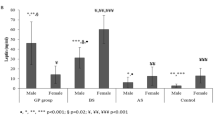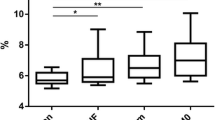Abstract
Background
The effects of bariatric surgery (BS) in metabolically healthy morbidly obese (MO) subjects are not well established. Against this background, we characterized the metabolic and inflammatory profiles of MO subjects with insulin sensitivity (IS) in the normal range, and evaluated the changes on these parameters following BS in this population.
Methods
We conducted a retrospective analysis of prospectively collected data in MO women undergoing BS between 2006 and 2010. Anthropometric, metabolic comorbidities, and inflammatory markers were compared at baseline and 12 months after BS, between 52 women (10.4 %) presenting with a HOMA-IR <2.94 (80th percentile reference population) (IS-MO group) and an age- and BMI-matched group of women (n = 52) with HOMA-IR >2.94.
Results
The IS-MO women presented a more favorable metabolic and inflammatory profile as compared to the IR-MO group. However, an enlarged waist circumference (WC), a high-sensitivity C-reactive protein (hs-CRP) >3 mg/dL, and metabolic syndrome (MS) were present in 100 %, 90 %, and 51.9 % of the IS-MO group at baseline. At 12 months after surgery, all the MS components and hs-CRP improved in IS-MO subjects (p < 0.01). The prevalence of the MS in the IS-MO group significantly decreased (11 %, p < 0.05) despite WC and hs-CRP being abnormal respectively in 53.3 % and 20.0 % of women in this group.
Conclusions
In MO women, an IS in the normal range is associated with a limited protection from metabolic co-morbidities. Nonetheless, BS results in the amelioration of the altered metabolic and inflammatory profiles also in this group of subjects.
Similar content being viewed by others
References
Ferrannini E, Haffner SM, Mitchell BD, et al. Hyperinsulinemia: the key feature of cardiovascular and metabolic syndrome. Diabetologia. 1991;34:416–22.
Karelis AD, Faraj M, Bastard JP, et al. The metabolically healthy but obese individual presents a favorable inflammation profile. J Clin Endocrinol Metab. 2005;90:4145–50.
Marini MA, Succurro E, Frontoni S, et al. Metabolically healthy but obese women have an intermediate cardiovascular risk profile between healthy non obese women and insulin-resistant women. Diabetes Care. 2007;30:2145–7.
Meigs JB, Wilson PW, Fox CS, et al. Body mass index, metabolic syndrome, and risk of type 2 diabetes or cardiovascular disease. J Clin Endocrinol Metab. 2006;91:2906–12.
Brochu M, Tchernof A, Dionne IJ, et al. What are the physical characteristics associated with a normal metabolic profile. J Clin Endocrinol Metab. 2001;86:1020–5.
Jennings CL, Lambert EV, Collins M, et al. Determinants of insulin-resistance phenotypes in normal weight and obese Black African women. Obesity. 2008;16:1602–9.
Soverini V, Moscatiello S, Villanova N, et al. Metabolic syndrome and insulin resistance in subjects with morbid obesity. Obes Surg. 2010;20:295–301.
Shin MJ, Hyun YJ, Kim OY, et al. Weight loss effect on inflammation and LDL oxidation in metabolically healthy but obese (MHO) individuals: low inflammation and LDL oxidation in MHO women. Int J Obes (Lond). 2006;30:1529–34.
Karelis AD, Messier V, Brochu M, et al. Metabolically healthy but obese women: effect of an energy-restricted diet. Diabetologia. 2008;51:1752–4.
Matthews DR, Hosker JP, Rudenski AS, et al. Homeostasis model assessment: insulin resistance and beta-cell function from fasting plasma glucose and insulin concentrations in men. Diabetologia. 1985;28:412–9.
Vidal J, Morinigo R, Codoceo VH, et al. The importance of diagnostic criteria in the association between metabolic syndrome and cardiovascular disease in obese subjects. Int J Obes. 2005;29:668–74.
Vidal J, Ibarzabal A, Nicolau J, et al. Short-term effects of sleeve gastrectomy on type 2 diabetes mellitus in severely obese subjects. Obes Surg. 2007;17:1069–74.
American Diabetes Association. Diagnosis and classification of diabetes mellitus. Diabetes Care. 2012;35:S64–71.
Grundy SM, Cleeman JI, Daniels S, et al. Diagnosis and management of metabolic syndrome: an American Heart Association/National Heart Lung, and Blood Institute scientific statement. Circulation. 2005;112:2735–52.
Pataky Z, Bobbioni-Harsch E, Golay A. Open questions about metabolically normal obesity. Int J Obes. 2010;34:S18–23.
Weiss R, Taksali SE, Dufour S, et al. The “obese insulin-sensitive” adolescent: importance of adiponectin and lipid partitioning. J Clin Endocrinol Metab. 2005;90:3731–7.
Stefan N, Kantartzis K, Macann J, et al. Identification and characterization of metabolically benign obesity in humans. Arch Intern Med. 2008;168:1609–16.
Olefsky JM, Glass CK. Macrophages, inflammation and insulin resistance. Annu Rev Physiol. 2010;72:219–46.
Ardern CL, Janssen I, Ross R, et al. Development of health-related waist circumference thresholds within BMI categories. Obes Res. 2004;12:1094–103.
Barbarroja N, López-Pedrera R, Mayas MD, et al. The obesity healthy paradox: is inflammation the answer? Biochem J. 2010;430:141–9.
Ridker PM, Hennekens CH, Buring JE, et al. C-reactive protein and other markers of inflammation in the prediction of cardiovascular disease in women. N Engl J Med. 2000;342:836–43.
Chang I, Ryu S, Suh BS, et al. Impact of BMI on incidence of metabolic abnormalities in metabolically healthy men. Int J Obes (Lond). 2011. doi:10.1038/ijo.2011.247.
Tschoner A, Sturm W, Engl K, et al. Retinol-binding protein, visceral fat, and the metabolic syndrome: effects of weight loss. Obesity. 2008;16:2439–44.
Conflict of Interest
As authors of this manuscript, Amanda Jiménez, Verónica Perea, Ricard Corcelles, Violeta Moizé, Antonio Lacy, and Josep Vidal declare that they do not have competing financial interests to disclose in relation to the work described herein.
Disclosure Statement
The authors have no conflicts of interest to disclose.
Author information
Authors and Affiliations
Corresponding author
Rights and permissions
About this article
Cite this article
Jiménez, A., Perea, V., Corcelles, R. et al. Metabolic Effects of Bariatric Surgery in Insulin-Sensitive Morbidly Obese Subjects. OBES SURG 23, 494–500 (2013). https://doi.org/10.1007/s11695-012-0817-7
Published:
Issue Date:
DOI: https://doi.org/10.1007/s11695-012-0817-7




